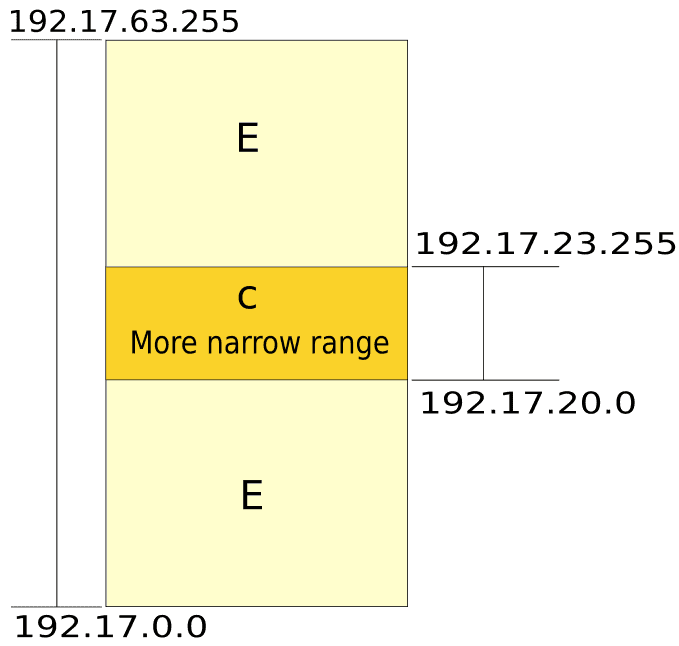1. 概述
在本教程中,我们将介绍 IP前缀 的基本概念,以及在网络中使用最长前缀匹配(Longest Prefix Matching)进行数据包转发的原理,并通过示例进行说明。
IP前缀用于表示一个IP地址的范围,而最长前缀匹配则是路由选择中的关键技术,用于在多个匹配的路由条目中选出最合适的一条。
2. IP前缀的表示方法
IP地址是用于标识互联网上设备位置的唯一标识符,常见的有 IPv4 和 IPv6 两种版本。IPv4 使用 32 位地址,而 IPv6 则使用 128 位地址。
一个 IP前缀 由 IP地址 和 前缀长度 两部分组成,例如:
192.168.64.0/18
其中:
192.168.64.0是该地址段的第一个地址;/18表示前 18 位是固定不变的,后面的 14 位可以变化。
我们来看这个例子的二进制形式:
11000000.10101000.01000000.00000000
其中前 18 位(加粗部分)是固定不变的,后 14 位可以变化,因此这个前缀一共能表示 2^14 = 16384 个IP地址。
该地址段的最后一个IP地址为:
192.168.127.255
其二进制形式为:
11000000.10101000.01111111.11111111
✅ 关键点:前缀长度决定了哪些位是固定的,哪些位是可变的。
3. 数据包转发机制
在网络中,数据包根据其目标IP地址在路由器之间转发,这个过程称为数据包转发。
每个路由器都维护一个转发表(Forwarding Table),用于决定数据包下一步应该发往哪个路由器。
转发表中的每一项是一个IP前缀,对应一个下一跳路由器(Next Hop)。当一个数据包到达路由器时,它会根据目标IP地址查找转发表,找到匹配的前缀,然后将数据包转发给对应的下一跳。
⚠️ 注意:一个IP地址可能同时匹配多个前缀,这就需要使用最长前缀匹配算法来决定最终路由。
4. 最长前缀匹配原理
最长前缀匹配(Longest Prefix Matching)是解决路由表中多个匹配项冲突的关键技术。
举个例子帮助理解:
假设你要寄一封信到某个地址,有两个选项:
- 交给城市邮局的快递员(较粗粒度)
- 交给具体小区的派送员(更细粒度)
显然,交给小区派送员更高效。类似地,在路由中,我们选择前缀更长(即掩码更细)的路由条目,因为它更具体、更精确。
✅ 最长前缀匹配原则:前缀长度越长,优先级越高。
这样可以确保数据包被更精准地转发到目标网络,避免不必要的跳转。
5. 示例演示
假设一个数据包的目标IP地址为:
192.17.21.26
当前路由器的转发表如下:
| 前缀 | 二进制表示 | 下一跳路由器 |
|---|---|---|
| 192.17.0.0/18 | 11000000.00010001.0.0 | E |
| 192.17.20.0/22 | 11000000.00010001.000101.0 | C |
| 192.20.0.0/16 | 11000000.00010100.0.0 | D |
我们来分析目标IP地址的二进制形式:
11000000.00010001.00010101.00011010
分别与各前缀进行匹配:
- 匹配
/18:前 18 位匹配 ✅ - 匹配
/22:前 22 位匹配 ✅(比/18更长) - 匹配
/16:前 16 位匹配 ✅(但比/22更短)
✅ 最终选择 /22 对应的下一跳路由器 C。
如果没有任何匹配项,则使用默认路由(Default Route)作为兜底策略。
🔍 实现方式:通常使用 Trie(前缀树)这类数据结构快速查找最长匹配前缀。
下图展示了 /18 和 /22 地址段的覆盖范围:

6. 总结
本文介绍了:
- IP前缀的结构和表示方式
- 数据包转发的基本机制
- 路由冲突问题及最长前缀匹配的解决思路
- 实际示例演示最长前缀匹配过程
最长前缀匹配是现代网络路由中不可或缺的核心机制,它确保了即使存在多个匹配路由项,也能选择出最精确的一条路径,从而提高网络转发效率与准确性。